英语五种基本句型与八大时态
英语五种基本句型与八大时态
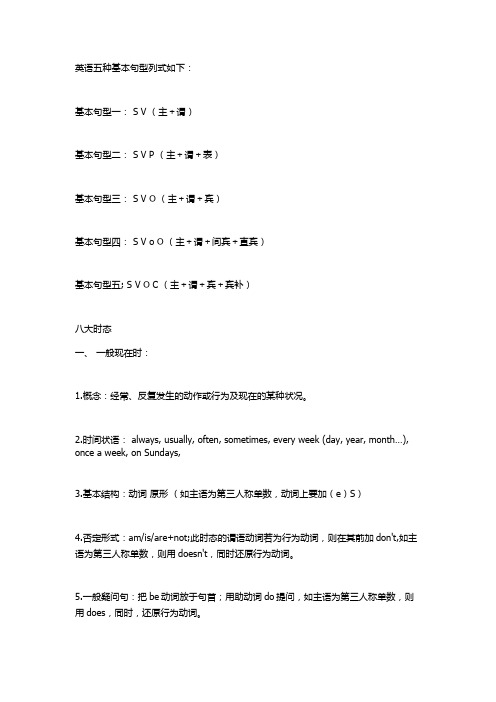
英语五种基本句型列式如下:基本句型一: S V (主+谓)基本句型二: S V P (主+谓+表)基本句型三: S V O (主+谓+宾)基本句型四: S V o O (主+谓+间宾+直宾)基本句型五; S V O C (主+谓+宾+宾补)八大时态一、一般现在时:1.概念:经常、反复发生的动作或行为及现在的某种状况。
2.时间状语: always, usually, often, sometimes, every week (day, year, month…), once a week, on Sundays,3.基本结构:动词原形(如主语为第三人称单数,动词上要加(e)S)4.否定形式:am/is/are+not;此时态的谓语动词若为行为动词,则在其前加don't,如主语为第三人称单数,则用doesn't,同时还原行为动词。
5.一般疑问句:把be动词放于句首;用助动词do提问,如主语为第三人称单数,则用does,同时,还原行为动词。
6.例句:. It seldom snows here.He is always ready to help others.Action speaks louder than words.二、一般过去时:1.概念:过去某个时间里发生的动作或状态;过去习惯性、经常性的动作、行为。
2.时间状语:ago, yesterday, the day before yesterday, last week(year, night, month…), in 1989, just now, at the age of 5, one day, long long ago, once upon a time, etc.3.基本结构:be动词;行为动词4.否定形式:was/were+not;在行为动词前加didn't,同时还原行为动词。
5.一般疑问句:was或were放于句首;用助动词do的过去式did 提问,同时还原行为动词。
谓语动词八大时态
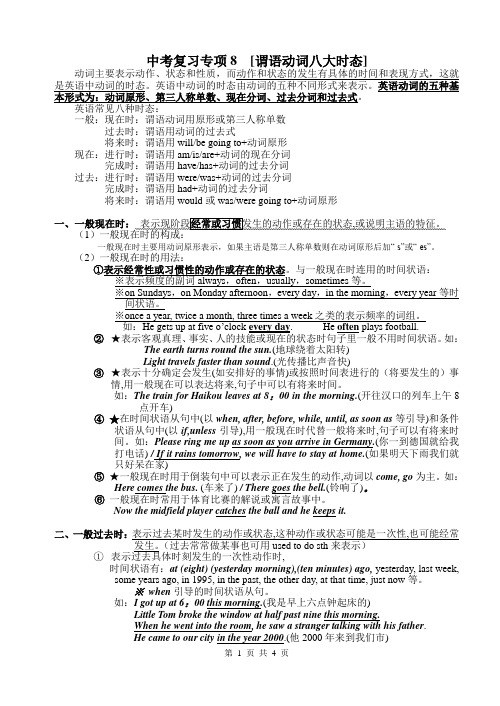
中考复习专项8 [谓语动词八大时态]动词主要表示动作、状态和性质,而动作和状态的发生有具体的时间和表现方式,这就是英语中动词的时态。
英语中动词的时态由动词的五种不同形式来表示。
英语动词的五种基本形式为:动词原形、第三人称单数、现在分词、过去分词和过去式。
英语常见八种时态:一般:现在时:谓语动词用原形或第三人称单数过去时:谓语用动词的过去式将来时:谓语用will/be going to+动词原形现在:进行时:谓语用am/is/are+动词的现在分词完成时:谓语用have/has+动词的过去分词过去:进行时:谓语用were/was+动词的过去分词完成时:谓语用had+动词的过去分词将来时:谓语用would或was/were going to+动词原形(1一般现在时主要用动词原形表示,如果主语是第三人称单数则在动词原形后加“-s”或“-es”。
(2)一般现在时的用法:①表示经常性或习惯性的动作或存在的状态。
与一般现在时连用的时间状语:※表示频度的副词always,often,usually,sometimes等。
※on Sundays,on Monday afternoon,every day,in the morning,every year等时间状语。
※once a year, twice a month, three times a week之类的表示频率的词组。
如:He gets up at five o’clock every day. He often plays football.②★表示客观真理、事实、人的技能或现在的状态时句子里一般不用时间状语。
如:The earth turns round the sun.(地球绕着太阳转)Light travels faster than sound.(光传播比声音快)③★表示十分确定会发生(如安排好的事情)或按照时间表进行的(将要发生的)事情,用一般现在可以表达将来,句子中可以有将来时间。
英语八大时态总结表8种基本时态结构句型

英语八大时态总结表8种基本时态结构句型英语八大时态分别是:一般现在时、一般过去时、现在进行时、过去进行时、现在完成时、过去完成时、一般将来时和过去将来时。
一般现在时:经常、反复发生的动作或行为及现在的某种状况。
时间状语:always, usually, often, sometimes, every week day, year, month…, once a week, on Sundays, etc.基本结构:①be动词;②行为动词否定形式:①am/is/are+not; ②此时态的谓语动词若为行为动词,则在其前加don't,如主语为第三人称单数,则用doesn't,同时还原行为动词。
一般疑问句:①把be动词放于句首;②用助动词do提问,如主语为第三人称单数,则用does,同时,还原行为动词。
一般过去时:过去某个时间里发生的动作或状态;过去习惯性、经常性的动作、行为。
时间状语:ago, yesterday, the day before yesterday, last weekyear, night, month…, in 1989, just now, at the age of 5, one day, long long ago, once upon a time, etc.基本结构:①be动词;②行为动词否定形式:①was/were+not;②在行为动词前加didn't,同时还原行为动词。
一般疑问句:①was或were放于句首;②用助动词do的过去式did 提问,同时还原行为动词。
现在进行时:表示现阶段或说话时正在进行的动作及行为。
时间状语:now, at this time, these days, etc.基本结构:am/is/are+doing否定形式:am/is/are+not+doing.一般疑问句:把be动词放于句首。
过去进行时:表示过去某段时间或某一时刻正在发生或进行的行为或动作。
五种句型八大时态七大语法

五种句型八大时态七大语法一、五种句型1、简单句:由一个主语和一个谓语组成,是最基本的句型,如:He goes to school.2、并列句:由两个或两个以上的并列句子组成,如:He goes to school and she goes to work.3、复合句:由一个主句和一个从句组成,如:He goes to school when he is free.4、倒装句:将句子中的谓语动词放在主语之前,如:Here comes the bus.5、感叹句:表示感情的句子,如:What a beautiful day!二、八大时态1、一般现在时:表示经常性或习惯性的动作,如:He goes to school every day.2、一般过去时:表示过去发生的动作,如:He went to school yesterday.3、一般将来时:表示将来发生的动作,如:He will go to school tomorrow.4、现在进行时:表示正在进行的动作,如:He is going to school now.5、现在完成时:表示过去发生的动作对现在造成的影响,如:He has gone to school.6、过去进行时:表示过去正在进行的动作,如:He was going to school.7、过去完成时:表示过去发生的动作对过去造成的影响,如:He had gone to school.8、将来完成时:表示将来发生的动作对将来造成的影响,如:He will have gone to school.三、七大语法1、名词:表示人、事物或抽象概念的词,如:school, teacher, happiness.2、代词:替代名词的词,如:he, she, it.3、形容词:修饰名词的词,如:beautiful, tall, happy.4、动词:表示动作或状态的词,如:go, be, have.5、副词:修饰动词、形容词或其他副词的词,如:quickly, very, almost.6、介词:表示词与词之间的关系的词,如:in, on, at.7、连词:连接句子成分的词,如:and, but, or.。
八种英语时态基本句型
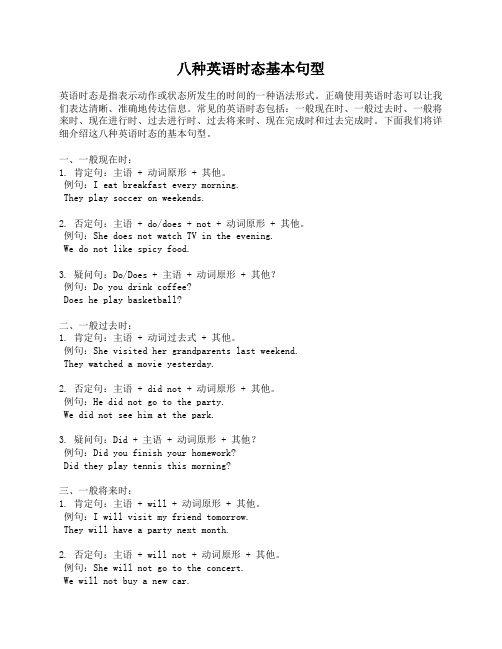
八种英语时态基本句型英语时态是指表示动作或状态所发生的时间的一种语法形式。
正确使用英语时态可以让我们表达清晰、准确地传达信息。
常见的英语时态包括:一般现在时、一般过去时、一般将来时、现在进行时、过去进行时、过去将来时、现在完成时和过去完成时。
下面我们将详细介绍这八种英语时态的基本句型。
一、一般现在时:1. 肯定句:主语 + 动词原形 + 其他。
例句:I eat breakfast every morning.They play soccer on weekends.2. 否定句:主语 + do/does + not + 动词原形 + 其他。
例句:She does not watch TV in the evening.We do not like spicy food.3. 疑问句:Do/Does + 主语 + 动词原形 + 其他?例句:Do you drink coffee?Does he play basketball?二、一般过去时:1. 肯定句:主语 + 动词过去式 + 其他。
例句:She visited her grandparents last weekend.They watched a movie yesterday.2. 否定句:主语 + did not + 动词原形 + 其他。
例句:He did not go to the party.We did not see him at the park.3. 疑问句:Did + 主语 + 动词原形 + 其他?例句:Did you finish your homework?Did they play tennis this morning?三、一般将来时:1. 肯定句:主语 + will + 动词原形 + 其他。
例句:I will visit my friend tomorrow.They will have a party next month.2. 否定句:主语 + will not + 动词原形 + 其他。
(完整版)英语常用的八种时态

英语时态初中阶段应掌握的时态共有八种,即一般现在时,一般将来时,一般过去时,现在进行时,过去进行时,过去将来时,现在完成时,过去完成时。
现从结构,作用,时间状语三方面加以介绍。
●动词形式分五种:1.动词原形→ 2.第三人称单数→ 3.过去式→ 4.过去分词→ 5.现在分词一、一般现在时其结构为:be动词肯定句主语+am,is,are+其它。
否定句主语+am,is,are + not+其它。
一般疑问句 Am,Is,Are+主语+其它?特殊疑问句特殊疑问词+am,is,are+主语+其它?实意动词1)主语为第一,二人称及第三人称复数时肯定句主语+动词原形+其它。
否定句主语+don't+动词原形+其它。
一般疑问句 Do +主语+动词原形+其它?特殊疑问句特殊疑问词+do+主语+动词原形+其它?2)主语为第三人称单数时肯定句主语+动词第三人称单数 +其它。
否定句主语+doesn't+动词原形+其它。
一般疑问句 Does+主语+动词原形+其它?特殊疑问句特殊疑问词+does+主语+动词原形+其它?其作用为:表示习惯性,经常性的动作;表示现在的状态与特征;表示普遍真理其常用时间状语为often,always,usually,sometimes,everyday(week,year...), in the morning(afternoon,evening)等。
Ex . 1. _______ she _______ (go)to the library every Sunday?此题为习惯性动作,答案为Does,go.2.They often _______(swim)in summer.此题为经常性动作,答案为swim.3.______(be)everyone here?此题表示现在的状态,答案为Is.4.The earth______(travel) round the sun.此题表示普遍真理,答案为travels.二、一般过去时其结构为:be动词肯定句主语+was,were+其它。
2022年全国中考英语语法八大时态及句式

中考语法八大时态及重点句式五大基础句型:(谓语指动词,宾语指名词,放动词后面)1. 主+谓The winter comes.2.主+谓+宾He likes apples.3. 主+谓+双宾(谁给谁干了一件什么事情)=主+谓+间宾+直宾(间宾指人,直宾指物)You give me a book.=You give a book to me.4.主+谓+宾+宾补(对宾语的补充,怎么样)He feels English easy.5.主系表结构(表达主语是什么状态,……怎么样)a. be动词用法主+be动词+形/名She is cute/ She is Grace.b. ……闻起来/听起来主+感观动词+形容词It looks beautiful.句子的八种基本时态其实语法用上面的表格就可以很明白它的搭配了,下面例句用数字对应到表格里,用一个洗车系列的例句来看就更加清楚了哈一. 一般时(一般时) 1.He washes his car every day.二. 进行时过去:(一般时) 2.He washed his car yesterday.(进行时) 3.He was washing his car when I suddenly saw him.现在:(一般时)1. He washes his car four times a week.(进行时) 4. Look!He is washing his car now.将来:(一般时)5. He will wash his car tomorrow.三.完成时过去:(完成时)6.He had washed his car before I got to his house.现在:(完成时)7.He has already washed his car.四.过去将来时过去时间的将来(过去将来时)8. Yesterday he said he would wash the car, buthe didn’t.总结下时态的标志词:1.一般现在时:always,often,usually,sometimes,every day2.一般过去时:yesterday,last week,in 1998,two days ago3.现在进行时:now, right now, at the moment, these days, look!4.过去进行时:at seven yesterday morning, from 9 to 10 last night, at this time last Monday, when someone knocked at the door5.一般将来时:tomorrow,next week,next year,in the future6.过去将来时:从过去某一时间看来将要发生的动作或存在的状态。
英语八大时态总结表 8种基本时态结构句型
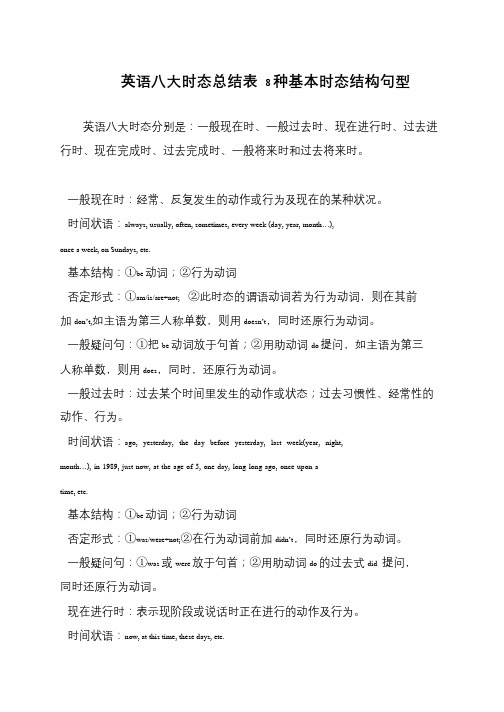
英语八大时态总结表8 种基本时态结构句型英语八大时态分别是:一般现在时、一般过去时、现在进行时、过去进行时、现在完成时、过去完成时、一般将来时和过去将来时。
一般现在时:经常、反复发生的动作或行为及现在的某种状况。
时间状语:always, usually, often, sometimes, every week (day, year, month…),once a week, on Sundays, etc.基本结构:①be 动词;②行为动词否定形式:①am/is/are+not; ②此时态的谓语动词若为行为动词,则在其前加don’t,如主语为第三人称单数,则用doesn’t,同时还原行为动词。
一般疑问句:①把be 动词放于句首;②用助动词do 提问,如主语为第三人称单数,则用does,同时,还原行为动词。
一般过去时:过去某个时间里发生的动作或状态;过去习惯性、经常性的动作、行为。
时间状语:ago, yesterday, the day before yesterday, last week(year, night,month…), in 1989, just now, at the age of 5, one day, long long ago, once upon atime, etc.基本结构:①be 动词;②行为动词否定形式:①was/were+not;②在行为动词前加didn’t,同时还原行为动词。
一般疑问句:①was 或were 放于句首;②用助动词do 的过去式did 提问,同时还原行为动词。
现在进行时:表示现阶段或说话时正在进行的动作及行为。
时间状语:now, at this time, these days, etc.。
英语八大时态用法详解
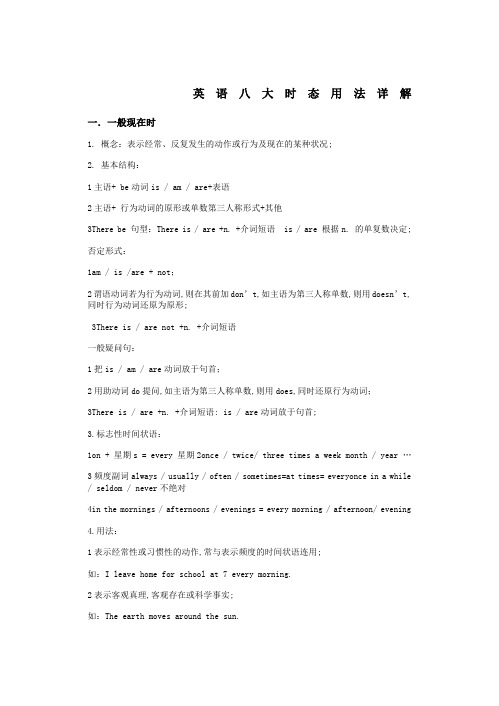
英语八大时态用法详解一.一般现在时1. 概念:表示经常、反复发生的动作或行为及现在的某种状况;2. 基本结构:1主语+ be动词is / am / are+表语2主语+ 行为动词的原形或单数第三人称形式+其他3There be 句型:There is / are +n. +介词短语 is / are 根据n. 的单复数决定;否定形式:1am / is /are + not;2谓语动词若为行为动词,则在其前加don’t,如主语为第三人称单数,则用doesn’t,同时行为动词还原为原形;3There is / are not +n. +介词短语一般疑问句:1把is / am / are动词放于句首;2用助动词do提问,如主语为第三人称单数,则用does,同时还原行为动词;3There is / are +n. +介词短语: is / are动词放于句首;3.标志性时间状语:1on + 星期s = every 星期2once / twice/ three times a week month / year …3频度副词always / usually / often / sometimes=at times= everyonce in a while / seldom / never不绝对4in the mornings / afternoons / evenings = every morning / afternoon/ evening4.用法:1表示经常性或习惯性的动作,常与表示频度的时间状语连用;如:I leave home for school at 7 every morning.2表示客观真理,客观存在或科学事实;如:The earth moves around the sun.3表示格言或警句;如:Pride goes before a fall. 骄者必败;注意:此用法如果出现在宾语从句中,即使主句是过去时,从句谓语也要用一般现在时;如:Columbus proved that the earth is round.4表示现在时刻的状态、能力、性格、个性等;如:I don’t want so much.Ann writes good English but does not speak well.5一般现在时表示将来含义① come, go, arrive, leave, start, begin, return的一般现在时可以表示将来,主要用来表示在时间上已确定或安排好的事情;如:The train leaves at six tomorrow morning.— When does the bus star— It stars in ten minutes.②在时间或条件状语句中;如:When Bill comes 不是will come, ask him to wait for me.I’ll write to you as soon as I arrive there.二.一般过去时1. 概念:表示过去某个时间里发生的动作或状态;过去习惯性、经常性的动作或行为;2. 基本结构:1主语+ was / were +表语2主语+ 行为动词的过去式 +其他3There be 句型:There was / were +n. +介词短语4主语+could+动词原形5主语+used to do sth否定形式:1was / were + not;2在行为动词前加didn’t,同时还原行为动词;3There was / were not +n. +介词短语4主语+could not +动词原形5主语+used not to do sth或主语+didn’t use to do sth一般疑问句:1was或were放于句首;2用助动词do的过去式did 提问,同时还原行为动词;3There was / were +n. +介词短语:was或were放于句首;4could放于句首;5Used主语+ to do sth或Did+主语+use to do sth3.时间状语:1last 短语2时间段+ago 3yesterday及yesterday短语4at the age of = when sb. was+年龄5in one’s teens / twenties6固定短语:just now=a moment ago, one day, from then on, at that time, the day before yesterday, before, long before, in the past , in the / early old days, in the ancient days, in the ancient + 国家,long long ago = once upon a time 故事的开头4. 用法:1在确定的过去时间里所发生的动作或存在的状态;如:Where did you go just now2表示在过去一段时间内,经常性或习惯性的动作;如:When I was a child, I often played football in the street.注意:used to do sth“过去常常做某事”,表示过去习惯性的动作或状态,但如今已不存在;如:Mother used not to be so forgetful. 妈妈过去没这么健忘;3用于时间状语从句a. 由when 引导的时间状语从句,从句用一般过去时态,主句用过去进行时态;如:His mother was cooking when he came back.b. 由since/before 引导的时间状语从句,从句用一般过去时态,主句用现在完成时态;如:I have made many friends since I came to China.It has been/is 15 years since I was a teacher.It has been/is 15 years before he knew it. 不知不觉15 年过去了;c. 由when / by the time/ before引导的时间状语从句,从句用一般过去时态,主句用过去完成时态;如:The plane had taken off when / by the time we arrived at the airport.The Enlish class had begun before I got to school.三.现在进行时1. 概念:表示现阶段或说话时正在进行的动作及行为;2. 基本结构:主语 + am / is /are + doing否定形式:主语 + am / is / are + not + doing一般疑问句:把be动词放于句首;3.时间状语:(1)now 2at this time = at this / the moment 3Look/Look at …4Listen / Listen to …5these days / months / years6It is+ 时间点/日期/星期4. 用法:1表示现在指说话人说话时正在发生的事情;如:We are waiting for you.2表示长期的或重复性的动作,说话时动作未必正在进行;如:Mr Green is writing another novel. 说话时并不一定在写小说3表示动作的渐变,这样的动词有:get, grow, become, turn, run, go, begin等;如:The leaves are turning red.It’s getting warmer and warmer.4与always, constantly, forever 等词连用,表示反复发生的动作或持续存在的状态,往往带有说话人的主观色彩;如:You are always changing your mind. 你老是改变主意;5用现在进行时表示将来下列动词come, go, arrive, leave, start, begin, return等瞬间动词的现在进行时可以表示将来;如:I’m leaving tomorrow.四.过去进行时1. 概念:表示过去某段时间或某一时刻正在发生或进行的行为或动作;如:My brother fell while he was riding his bicycle and hurt himself.2. 基本结构:主语 + was / were + doing否定形式:主语 + was / were + not + doing一般疑问句:把was或were放于句首;3. 时间状语:1at that time2at this time+过去的时间3It was+ 时间点/ 日期/ 星期过去4from A时间 to B时间+过去的时间4. 用法:1过去进行时表示过去某段时间内持续进行的动作或者事情;如:We were watching TV from seven to nine last night.2过去进行时可以表示在过去某个时间点发生的事情;时间点可以用介词短语、副词或从句来表示;如:What was she doing at nine o’clock yesterday 介词短语表示时间点She was doing her homework then. 副词表示时间点When I saw him he was decorating his room. when从句表示时间点3在复合句中,如果主要动作和背景动作都是延续的或同时发生的,那么主从句的动词都可用过去进行时;如:When he was waiting for the bus, he was reading a newspaper. 两个动作都是延续的He was cleaning his car while I was cooking. 两个动作同时进行或主句的动作发生在从句的动作过程中五.一般将来时1. 概念:表示将要发生的动作或存在的状态及打算、计划或准备做某事;2. 基本结构:1主语 + am / is / are / going to do sth2主语 + will do sth3主语 + am / is /are t to do sth 4主语 + am / is /are about to do sth否定形式:1主语 + am / is /are + not + going to do sth2主语 + will notwon’t do sth3主语 + am / is /are not t to do sth 4主语 + am / is /are not about to do sth一般疑问句:1am / is / are放于句首;2will置于句首;3am / is / are放于句首;4am / is / are放于句首;2. 时间状语:1tomorrow及其短语、 the day after tomorrow2next短语3固定短语:one day, someday = some day, in the future, from now / today on, before long, sometime, in +时间段多长时间之后, in following+ 时间段4. will主要用于以下三个方面:1表示主观意愿的将来;如:They will go to visit the factory tomorrow.2表示不以人的意志为转移的客观的将来;如:Today is Saturday. Tomorrow will be Sunday.He will be thirty years old this time next year.3表示临时决定,通常用于对话中;— Mary has been ill for a week.— Oh, I didn’t know. I will go and see her.5. be going to主要用于以下两个方面:1表示事先经过考虑、打算、计划要做某事;如:Dad and I are going to watch an opera this afternoon.今天下午我和爸爸打算去看歌剧;2表示根据目前某种迹象判断,某事非常有可能发生,表示推测;如:Look There come the dark clouds. It is going to rain.6. 用于状语从句由when /as soon as / begore / after 等引导的时间状语从句或者if, unless, as/ so long as 引导的条件状语从句,从句用一般现在时态或从句为祈使句,再或者从句中含有情态动词,主句用一般将来时态;可理解为主将从现、主祈从现、主情从现如:Don’t trouble troubles until trouble troubles you.He will help you out whenever you have problems.I won't go to the partyunlessI'm invited.六.过去将来时1. 概念:立足于过去某一时刻,从过去看将来,常用于宾语从句中;2. 基本结构:1主语 + was / were / going to do sth2主语 + would do sth否定形式:1主语 + was / were / not + going to do sth2主语 + would + not + do sth一般疑问句:1was或were放于句首;2would 提到句首;3. 时间状语:the next day morning, year, the following month week等;4. 用法:1“would + 动词原形”常表示主观意愿的将来;如:He said he would come to see me. 他说他要来看我;2“was / were + going to + 动词原形”常表示按计划或安排即将发生的事;如:She said she was going to start off at once.I was told that he was going to return home.此结构还可表示根据某种迹象来看,很可能或即将发生的事情;如:It seemed as if it was going to rain. 看来好像要下雨;3come,go,leave,arrive,start等瞬时动词可用过去进行时表示过去将来的含义;如:He said the train was leaving at six the next morning.She told me she was coming to see me.七.现在完成时1. 概念:过去发生或已经完成的动作对现在造成的影响或结果,或从过去已经开始持续到现在并且有可能继续下去的动作或状态;3. 基本结构:主语 + have / has + done +其他否定形式:主语 + have / has + not +done +其他一般疑问句:Have / Has +主语 + done +其他4. 时间状语:1already 用于肯定句yet否定句和一般疑问句2just, ever, before, never3so far=up to now = until / till now = by now4over/ in the past /last +时间段5by + 时间6by the end of +现在的时间7since +过去时间如具体的年、月、日、钟点等,如:1980, last month, half past six8 since +一段时间+ ago 9recently = lately10in recent +时间段5. 特殊用法:1由since/before 引导的时间状语从句,从句用一般过去时态,主句用现在完成时态;如:I have made many friends since I came to China.It has been/is 15 years since I was a teacher.It has been/is 15 years before he knew it. 不知不觉15 年过去了;(2)用于由that引导的定语从句中,先行词前有形容词的最高级修饰;如:You’re the best teacher that has ever taught me.6. 比较since和forsince 用来说明动作起始时间,for用来说明动作延续时间的长度;如:We haven’t had any guests since we moved in here.I have lived here for more than twenty years.注意:并非有for 作为时间状语的句子都用现在完成时;I worked here for more than twenty years. 我现在已不在这里工作;7. 延续性动词与非延续性动词之间的转换:leave --- be away from borrow --- keep buy --- have begin/start --- be ondie --- be dead finish --- be over open sth --- keep sth openjoin --- be in+组织机构或be a member of+组织机构fall ill / asleep --- be ill / asleep get up---be upcatch / get a cold --- have a cold come here --- be here go there --- be therebecome / get +adj.--- be+adj come back --- be back get to/ arrive/reach --- be inget to know --- know go get out ---be out put on--- wear/ be in /be dressed in八.过去完成时1. 概念:以过去某个时间为参照,在此以前发生的动作或行为,或在过去某动作之前已完成的动作,即“过去的过去”;2. 基本结构:主语 + had done +其他否定形式:主语 + hadn’t done +其他一般疑问句:had置于句首;3. 时间状语:before, by the end of last yearterm, month等;4. 用法:1用于told, said, knew, heard, thought等动词后的宾语从句中;如:She said that she had never been to Paris.2由when / by the time/ before引导的时间状语从句,从句用一般过去时态,主句用过去完成时态;如:The plane had taken off when / by the time we arrived at the airport.The Enlish class had begun before I got to school.When the police arrived, the thieves had run away.3表示意向的动词,如hope, wish, expect, think, intend, mean, suppose等用过去完成时表示“原本······,未能······”;如:We had hoped that you would come, but you didn’t.注意: had hardly… when ... 刚······就······;如:I had hardly opened the door when he hit me. 我刚打开门,他就打了我; had no sooner…than 刚······就······;如:He had no sooner bought the car than he sold it. 他刚买了这辆车,转眼又卖了;。
英语八大时态概念
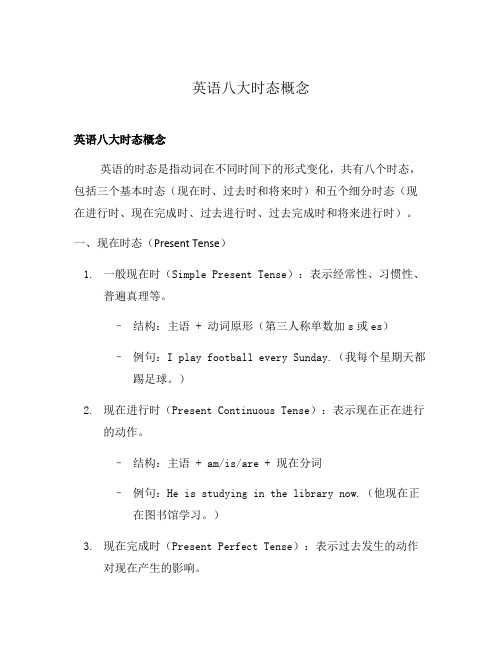
英语八大时态概念英语八大时态概念英语的时态是指动词在不同时间下的形式变化,共有八个时态,包括三个基本时态(现在时、过去时和将来时)和五个细分时态(现在进行时、现在完成时、过去进行时、过去完成时和将来进行时)。
一、现在时态(Present Tense)1.一般现在时(Simple Present Tense):表示经常性、习惯性、普遍真理等。
–结构:主语 + 动词原形(第三人称单数加s或es)–例句:I play football every Sunday.(我每个星期天都踢足球。
)2.现在进行时(Present Continuous Tense):表示现在正在进行的动作。
–结构:主语 + am/is/are + 现在分词–例句:He is studying in the library now.(他现在正在图书馆学习。
)3.现在完成时(Present Perfect Tense):表示过去发生的动作对现在产生的影响。
–结构:主语 + have/has + 过去分词–例句:I have visited Beijing many times.(我去过北京很多次。
)二、过去时态(Past Tense)1.一般过去时(Simple Past Tense):表示过去某个时间发生的动作或存在的状态。
–结构:主语 + 动词过去式–例句:She watched a movie last night.(她昨晚看了一部电影。
)2.过去进行时(Past Continuous Tense):表示过去某个时间正在进行的动作。
–结构:主语 + was/were + 现在分词–例句:They were playing basketball at 8 o’clock yesterday evening.(昨晚8点他们正在打篮球。
)3.过去完成时(Past Perfect Tense):表示过去某一时间或动作发生在另一过去时间之前。
初中英语语法八大时态总结
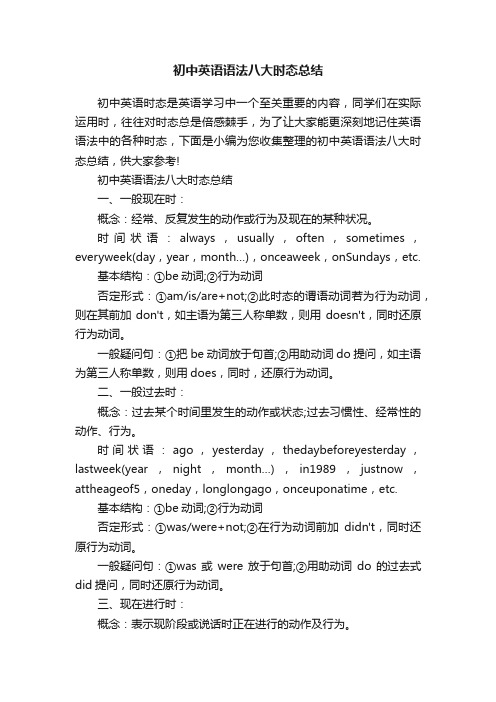
初中英语语法八大时态总结初中英语时态是英语学习中一个至关重要的内容,同学们在实际运用时,往往对时态总是倍感棘手,为了让大家能更深刻地记住英语语法中的各种时态,下面是小编为您收集整理的初中英语语法八大时态总结,供大家参考!初中英语语法八大时态总结一、一般现在时:概念:经常、反复发生的动作或行为及现在的某种状况。
时间状语:always,usually,often,sometimes,everyweek(day,year,month…),onceaweek,onSundays,etc.基本结构:①be动词;②行为动词否定形式:①am/is/are+not;②此时态的谓语动词若为行为动词,则在其前加don't,如主语为第三人称单数,则用doesn't,同时还原行为动词。
一般疑问句:①把be动词放于句首;②用助动词do提问,如主语为第三人称单数,则用does,同时,还原行为动词。
二、一般过去时:概念:过去某个时间里发生的动作或状态;过去习惯性、经常性的动作、行为。
时间状语:ago,yesterday,thedaybeforeyesterday,lastweek(year,night,month…),in1989,justnow,attheageof5,oneday,longlongago,onceuponatime,etc.基本结构:①be动词;②行为动词否定形式:①was/were+not;②在行为动词前加didn't,同时还原行为动词。
一般疑问句:①was或were放于句首;②用助动词do的过去式did提问,同时还原行为动词。
三、现在进行时:概念:表示现阶段或说话时正在进行的动作及行为。
时间状语:now,atthistime,thesedays,etc.基本结构:am/is/are+doing否定形式:am/is/are+not+doing.一般疑问句:把be动词放于句首。
四、过去进行时:概念:表示过去某段时间或某一时刻正在发生或进行的行为或动作。
英语五种基本句型与八大时态

英语五种基本句型列式如下:基本句型一: S V (主+谓)基本句型二: S V P (主+谓+表)基本句型三: S V O (主+谓+宾)基本句型四: S V o O (主+谓+间宾+直宾)基本句型五; S V O C (主+谓+宾+宾补)八大时态一、一般现在时:1.概念:经常、反复发生的动作或行为及现在的某种状况。
2.时间状语: always, usually, often, sometimes, every week (day, year, month…), once a week, on Sundays,3.基本结构:动词原形(如主语为第三人称单数,动词上要加(e)S)4.否定形式:am/is/are+not;此时态的谓语动词若为行为动词,则在其前加don't,如主语为第三人称单数,则用doesn't,同时还原行为动词。
5.一般疑问句:把be动词放于句首;用助动词do提问,如主语为第三人称单数,则用does,同时,还原行为动词。
6.例句:. It seldom snows here.He is always ready to help others.Action speaks louder than words.二、一般过去时:1.概念:过去某个时间里发生的动作或状态;过去习惯性、经常性的动作、行为。
2.时间状语:ago, yesterday, the day before yesterday, last week(year, night, month…), in 1989, just now, at the age of 5, one day, long long ago, once upon a time, etc.3.基本结构:be动词;行为动词4.否定形式:was/were+not;在行为动词前加didn't,同时还原行为动词。
5.一般疑问句:was或were放于句首;用助动词do的过去式did 提问,同时还原行为动词。
英语八大时态基本句型及例句

英语八大时态基本句型及例句英语中有八种基本时态,包括:现在简单时态、现在进行时态、现在完成时态、过去简单时态、过去进行时态、过去完成时态、将来简单时态和将来完成时态。
以下是每种时态的基本句型及例句:1. 现在简单时态(Present Simple Tense)基本句型:主语 + 动词原形(第三人称单数加s)例句:My sister reads books every day.(我姐姐每天都读书。
) 2. 现在进行时态(Present Continuous Tense)基本句型:主语 + am/is/are + 现在分词例句:I am studying English now.(我正在学英语。
)3. 现在完成时态(Present Perfect Tense)基本句型:主语 + have/has + 过去分词例句:She has visited many countries.(她去过很多国家。
) 4. 过去简单时态(Past Simple Tense)基本句型:主语 + 过去式动词例句:He went to the beach last weekend.(上周末他去了海滩。
)5. 过去进行时态(Past Continuous Tense)基本句型:主语 + was/were + 现在分词例句:They were playing basketball when it started to rain.(当下雨时他们正在打篮球。
)6. 过去完成时态(Past Perfect Tense)基本句型:主语 + had + 过去分词例句:I had finished my homework before my friends arrived.(朋友到达之前我已经完成了作业。
)7. 将来简单时态(Future Simple Tense)基本句型:主语 + will + 动词原形例句:I will help you with your project tomorrow.(我明天会帮你做项目。
英语的8大时态构成及造句
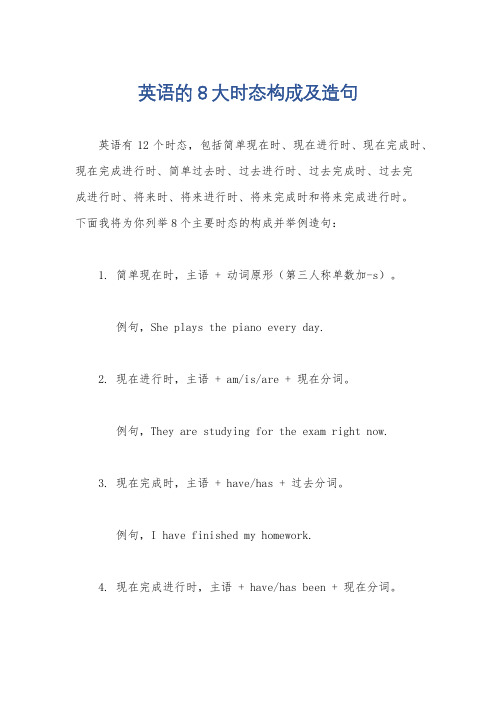
英语的8大时态构成及造句英语有12个时态,包括简单现在时、现在进行时、现在完成时、现在完成进行时、简单过去时、过去进行时、过去完成时、过去完成进行时、将来时、将来进行时、将来完成时和将来完成进行时。
下面我将为你列举8个主要时态的构成并举例造句:1. 简单现在时,主语 + 动词原形(第三人称单数加-s)。
例句,She plays the piano every day.2. 现在进行时,主语 + am/is/are + 现在分词。
例句,They are studying for the exam right now.3. 现在完成时,主语 + have/has + 过去分词。
例句,I have finished my homework.4. 现在完成进行时,主语 + have/has been + 现在分词。
例句,He has been working here for five years.5. 简单过去时,主语 + 动词过去式。
例句,We watched a movie last night.6. 过去进行时,主语 + was/were + 现在分词。
例句,She was reading a book when I called her.7. 过去完成时,主语 + had + 过去分词。
例句,They had already left when I arrived.8. 过去完成进行时,主语 + had been + 现在分词。
例句,By the time I got there, they had been waiting for over an hour.希望以上例句能够帮助你更好地理解这些时态的构成和用法。
英语8种时态基本结构
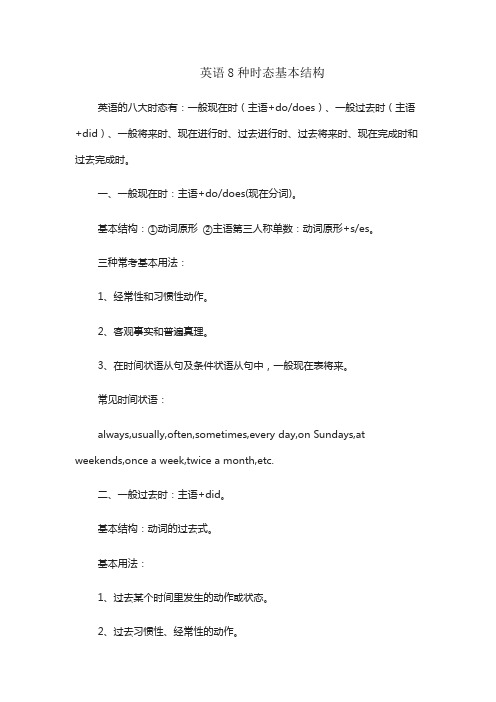
英语8种时态基本结构英语的八大时态有:一般现在时(主语+do/does)、一般过去时(主语+did)、一般将来时、现在进行时、过去进行时、过去将来时、现在完成时和过去完成时。
一、一般现在时:主语+do/does(现在分词)。
基本结构:①动词原形②主语第三人称单数:动词原形+s/es。
三种常考基本用法:1、经常性和习惯性动作。
2、客观事实和普遍真理。
3、在时间状语从句及条件状语从句中,一般现在表将来。
常见时间状语:always,usually,often,sometimes,every day,on Sundays,at weekends,once a week,twice a month,etc.二、一般过去时:主语+did。
基本结构:动词的过去式。
基本用法:1、过去某个时间里发生的动作或状态。
2、过去习惯性、经常性的动作。
常见时间状语:ago,yesterday,the day before yesterday,last week(year,night,month……),in 1986,just now,at the age of 10,at that time,once upon a time,etc.三、一般将来时:will do。
基本结构:①am/is/are/going to+do;②will/shall+do。
基本用法:1、(人)计划打算做某事。
2、(事)即将发生。
will/shall do。
1、将来的动作和状态(相对较长远)。
2、礼貌询问、客气邀请。
3、意愿。
常见时间状语:tomorrow,next day(week,month,year……),soon,the day after tomorrow,in+时间段(格外注意),etc.四、现在进行时:主语+am/is/are doing。
基本结构:am/is/are+现在分词。
基本用法:1、此时此刻正在进行的动作。
2、现阶段正在进行的动作。
英语语法八大时态总结(完整版)
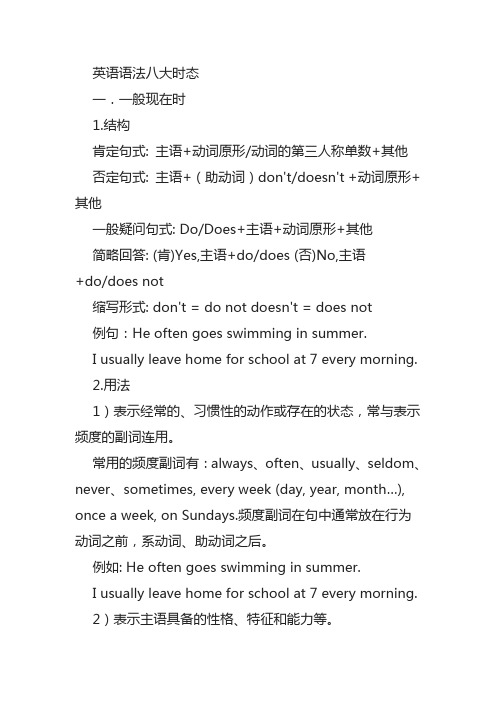
英语语法八大时态一.一般现在时1.结构肯定句式: 主语+动词原形/动词的第三人称单数+其他否定句式: 主语+(助动词)don't/doesn't +动词原形+其他一般疑问句式: Do/Does+主语+动词原形+其他简略回答: (肯)Yes,主语+do/does (否)No,主语+do/does not缩写形式: don't = do not doesn't = does not例句:He often goes swimming in summer.I usually leave home for school at 7 every morning.2.用法1)表示经常的、习惯性的动作或存在的状态,常与表示频度的副词连用。
常用的频度副词有:always、often、usually、seldom、never、sometimes, every week (day, year, month…), once a week, on Sundays.频度副词在句中通常放在行为动词之前,系动词、助动词之后。
例如: He often goes swimming in summer.I usually leave home for school at 7 every morning.2)表示主语具备的性格、特征和能力等。
例如:All my family love football .My sister is always ready to help others .Ann writes good English but does not speak well.3)表示客观真理、客观存在、自然现象。
例如:The earth moves around the sun.Shanghai lies in the east of China.4)表示按计划或安排好的,或将要发生的动作,可用一般现在时表将来。
英语语法八大时态总结 建议收藏
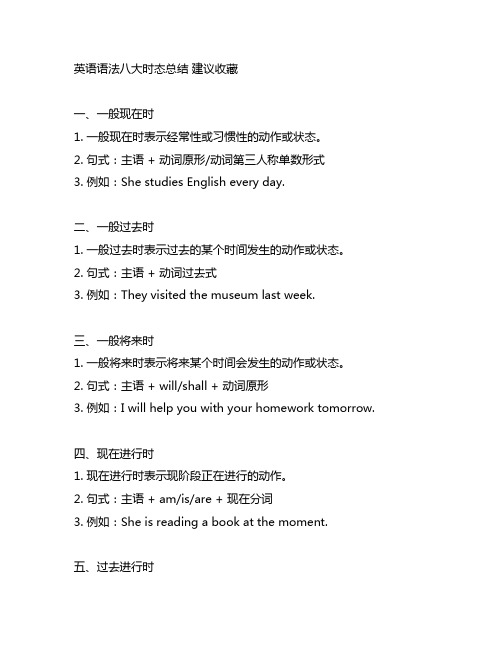
英语语法八大时态总结建议收藏一、一般现在时1. 一般现在时表示经常性或习惯性的动作或状态。
2. 句式:主语 + 动词原形/动词第三人称单数形式3. 例如:She studies English every day.二、一般过去时1. 一般过去时表示过去的某个时间发生的动作或状态。
2. 句式:主语 + 动词过去式3. 例如:They visited the museum last week.三、一般将来时1. 一般将来时表示将来某个时间会发生的动作或状态。
2. 句式:主语 + will/shall + 动词原形3. 例如:I will help you with your homework tomorrow.四、现在进行时1. 现在进行时表示现阶段正在进行的动作。
2. 句式:主语 + am/is/are + 现在分词3. 例如:She is reading a book at the moment.五、过去进行时1. 过去进行时表示过去某一时间正在进行的动作。
2. 句式:主语 + was/were + 现在分词3. 例如:They were playing football when it started to rain.六、现在完成时1. 现在完成时表示过去某个时间开始的动作一直持续到现在或对现在产生影响的动作。
2. 句式:主语 + have/has + 过去分词3. 例如:I have finished my homework.七、过去完成时1. 过去完成时表示在过去某个时间之前已经发生或完成的动作。
2. 句式:主语 + had + 过去分词3. 例如:She had already left when I arrived.八、将来完成时1. 将来完成时表示将来某个时间之前已经发生或完成的动作。
2. 句式:主语 + will/shall + have + 过去分词3. 例如:I will have completed the project by next month.总结回顾英语语法中的八大时态对于学习英语的人来说是十分重要的。
英语必考八大时态结构及用法详解
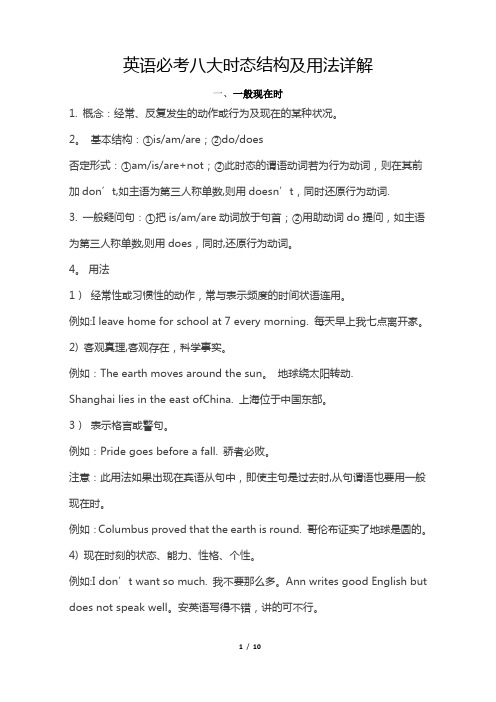
英语必考八大时态结构及用法详解一、一般现在时1. 概念:经常、反复发生的动作或行为及现在的某种状况。
2。
基本结构:①is/am/are;②do/does否定形式:①am/is/are+not;②此时态的谓语动词若为行为动词,则在其前加don’t,如主语为第三人称单数,则用doesn’t,同时还原行为动词.3. 一般疑问句:①把is/am/are动词放于句首;②用助动词do提问,如主语为第三人称单数,则用does,同时,还原行为动词。
4。
用法1)经常性或习惯性的动作,常与表示频度的时间状语连用。
例如:I leave home for school at 7 every morning. 每天早上我七点离开家。
2) 客观真理,客观存在,科学事实。
例如:The earth moves around the sun。
地球绕太阳转动.Shanghai lies in the east ofChina. 上海位于中国东部。
3)表示格言或警句。
例如:Pride goes before a fall. 骄者必败。
注意:此用法如果出现在宾语从句中,即使主句是过去时,从句谓语也要用一般现在时。
例如:Columbus proved that the earth is round. 哥伦布证实了地球是圆的。
4) 现在时刻的状态、能力、性格、个性。
例如:I don’t want so much. 我不要那么多。
Ann writes good English but does not speak well。
安英语写得不错,讲的可不行。
5)一般现在时表示将来含义a。
下列动词come, go, arrive, leave,start, begin, return的一般现在时可以表示将来,主要用来表示在时间上已确定或安排好的事情。
例如:The train leaves at six tomorrow morning. 火车明天上午六点开。
初中英语50个必考句型8大时态结构,你掌握了吗?
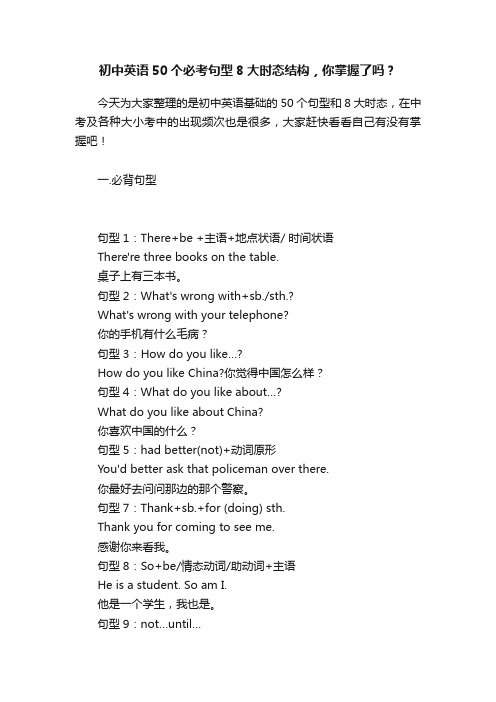
初中英语50个必考句型8大时态结构,你掌握了吗?今天为大家整理的是初中英语基础的50个句型和8大时态,在中考及各种大小考中的出现频次也是很多,大家赶快看看自己有没有掌握吧!一.必背句型句型1:There+be +主语+地点状语/ 时间状语There're three books on the table.桌子上有三本书。
句型2:What's wrong with+sb./sth.?What's wrong with your telephone?你的手机有什么毛病?句型3:How do you like…?How do you like China?你觉得中国怎么样?句型4:What do you like about…?What do you like about China?你喜欢中国的什么?句型5:had better(not)+动词原形You'd better ask that policeman over there.你最好去问问那边的那个警察。
句型7:Thank+sb.+for (doing) sth.Thank you for coming to see me.感谢你来看我。
句型8:So+be/情态动词/助动词+主语He is a student. So am I.他是一个学生,我也是。
句型9:not…until…He didn't have supper until his parents came back.直到他的父母回来他才吃饭。
句型10:比较级and+比较级The baby cried harder and harder.那孩子哭得越来越厉害。
句型11:the+比较级,the+比较级The more one has,the more one wants.拥有的越多,想要的越多。
句型12:…as+adj./adv.+as……not as(so)+adj./adv.+as…Last Sunday the weather was not so wet as it is today.上个星期天的天气不如今天的天气潮湿。
- 1、下载文档前请自行甄别文档内容的完整性,平台不提供额外的编辑、内容补充、找答案等附加服务。
- 2、"仅部分预览"的文档,不可在线预览部分如存在完整性等问题,可反馈申请退款(可完整预览的文档不适用该条件!)。
- 3、如文档侵犯您的权益,请联系客服反馈,我们会尽快为您处理(人工客服工作时间:9:00-18:30)。
英语五种基本句型列式如下:
基本句型
一:
S V (主+谓)
基本句型
二:
S V P (主+谓+表)
基本句型
三:
S V O (主+谓+宾)
基本句型
四:S V o O (主+谓+间宾+直宾)
基本句型五 ; S V O C (主+谓+宾+宾补)八大时态
一、一般现在时:
1.概念:经常、反复发生的动作或行为及现在的某种状况
2. 时间状always, usually, often, sometimes, every week (day, year, month⋯ ), once a week, on Sundays,
3. 基本结
构:
动词原形(如主语为第三人称单数,动词上要加( e) S)
4. 否定形式:
am/is/are+not; 此时态的谓语动词若为行为动词,则在其前加don't, 如
主语为第三人称单数,则用 doesn't ,同时还原行为动词
5. 一般疑问句:把 be 动词放于句首;用助动词 do 提问,如主语为第三人称单数,则用 does ,同时,还原行为动词。
6. 例句: . It seldom snows here.
He is always ready to help others.
Action speaks louder than words.
二、一般过去时:
1.概念:过去某个时间里发生的动作或状态;过去习惯性、经常性的动作、行为。
2.时间状语: ago, yesterday, the day before yesterday, last
week(year, night, month⋯ ), in 1989, just now, at the age of 5, one day, long long ago, once upon a time, etc.
3.基本结构: be 动词;行为动词
4.否定形式: was/were+not; 在行为动词前加 didn't ,同时还原行为动词。
5.一般疑问句: was 或 were 放于句首;用助动词 do 的过去式 did 提问,
同时还原行为动词。
6.例句: She often came to help us in those days.
I didn't know you were so busy.
三、现在进行时:
1.概念:表示现阶段或说话时正在进行的动作及行为
2.时间状语: now, at this time, these days, etc.
3.基本结构: am/is/are+doing
4.否定形式: am/is/are+not+doing.
5.一般疑问句:把 be 动词放于句首。
6. 例How are you feeling today
He is doing well in his lessons.
四、过去进行时:
1.概念:表示过去某段时间或某一时刻正在发生或进行的行为或动作
2. 时间状at this time yesterday, at that time 或以 when 引导的谓语般过去时的时间状语等。
3. 基本结
构:
was/were+doing
4. 否定形
式:was/were + not + doing.
5. 一般疑问句:把 was 或 were 放于句首。
6.例句: At that time she was working in a PLA unit.
When he came in, I was reading a newspaper.
五、现在完成时:
1.概念:过去发生或已经完成的动作对现在造成的影响或结果,或从过去已经开始,持续到现在的动作或状态。
2. 时间状语:recently, lately, since ⋯ for ⋯ ,in the past few years, etc.
3. 基本结
构:
have/has + done
4. 否定形
式:
have/has + not +d one.
5. 一般疑问
句:have 或 has 。
6. 例句: I've written an article.
It has been raining these days.
六、过去完成时:
1. 概念:以过去某个时间为标准,在此以前发生的动作或行为,或在过去某动作之前完成的行为,即“过去的过去”。
2.时间状语: before, by the end of last year(term, month ⋯ ),etc.
3.基本结构: had + done.
4.否定形式: had + not + done.
5.一般疑问句: had 放于句首。
6.例句: As soon as we got to the station, the train had left.
By the end of last month. We had reviewed four books
七、一般将来时:
1. 概念:表示将要发生的动作或存在的状态及打算、计划或准备做某事。
2.时间状语: tomorrow, next day(week, month, year ⋯ ),soon, in a few minutes,
by⋯ ,the day after tomorrow, etc.
3.基本结构: am/is/are/going to + do ; will/shall + do.
4.否定形式: was/were + not; 在行为动词前加 didn't ,同时还原行为动词。
5.一般疑问句: be 放于句首; will/shall 提到句首。
6.例句: They are going to have a competition with us in studies.
It is going to rain.
八、过去将来时:
1. 概念:立足于过去某一时刻,从过去看将来,常用于宾语从句中。
2.时间状语: the next day(morning, year ⋯ ),the following month(week ⋯ ),etc.
3.基本结构: was/were/going to + do ; would/should + do.
4.否定形式: was/were/not + going to + do;would/should + not + do.
5.一般疑问句: was 或 were 放于句首; would/should 提到句首。
6.例句: He said he would go to Beijing the next day。
